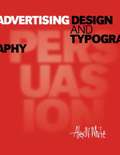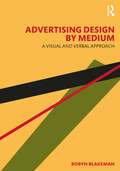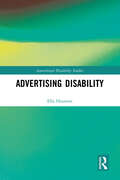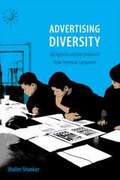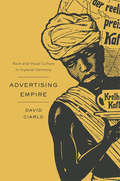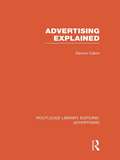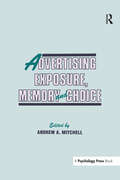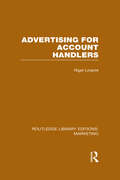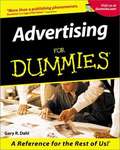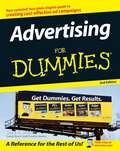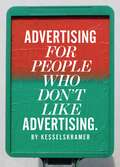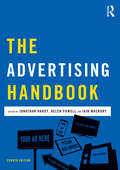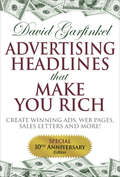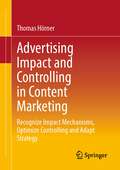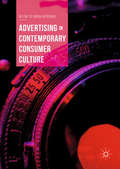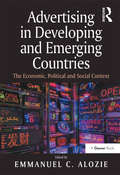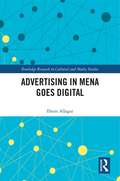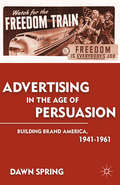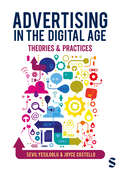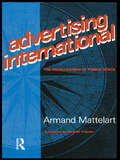- Table View
- List View
Advertising Design and Typography
by Alex W. WhiteThe most comprehensive overview of advertising design strategies on the market today! This unique, comprehensive overview of advertising design strategies, written by a best-selling, award-winning designer, will help students and professionals in advertising, design, and typography understand and use persuasive visual messaging. Design principles such as unity, contrast, hierarchy, dominance, scale, abstraction, and type and image relationships are covered in depth. Readers will also learn how print design compares to television, web, and interactive design, and how to apply each style to create persuasive designs. The extensive section on typography offers essential information on how readers perceive type, typographic history, principles, and practice. Helpful appendices include an extensive glossary, bibliography, and art director's checklist. Complete with more than 1,500 examples and illustrations of outstanding advertising design from around the world, Advertising Design and Typography is a groundbreaking book that will train the reader's mind to see more accurately and more critically-ultimately changing the way designers think and develop visual ideas. Best-selling design author has unique philosophy and expertise 1,500 full-color illustrations showcase outstanding advertising design from around the world Unique comparisons of print, web, TV and other campaigns-which techniques work best? Ideas for forging corporate identity through advertising
Advertising Design by Medium: A Visual and Verbal Approach
by Robyn BlakemanConceived to give readers the principles and the tools to create successful advertisements in a variety of mediums, this book is a detailed exploration of how visual and verbal elements of design work together to solve a business goal. Effective visual and verbal design solutions are more than just a good idea; they are purposeful, on-target, on-strategy, and recognizable no matter where, or in what form, they appear. Success depends on creative teams’ understanding of ideation, layout, type, color, varied image formats, copywriting, media advantages and limitations, and production procedures for varied media formats. The step-by-step approach of this book goes beyond broad theoretical discussions on copy and design. Instead, the book dissects the creative process into individualized and detailed discussions both creative and non-creative students alike can understand and employ. This book is ideal as a textbook for design courses within programs in advertising, graphic design, integrated marketing communication, strategic marketing, entrepreneurship, business, and mass communication. Accompanying the text are online materials for instructors: lecture slides, a testbank, and an instructor manual. www.routledge.com/9781032183596
Advertising Disability (Autocritical Disability Studies)
by Ella HoustonAdvertising Disability invites Cultural Disability Studies to consider how advertising, as one of the most ubiquitous forms of popular culture, shapes attitudes towards disability. The research presented in the book provides a much-needed examination of the ways in which disability and mental health issues are depicted in different types of advertising, including charity 'sadvertisements', direct-to-consumer pharmaceutical advertisements and 'pro-diversity' brand campaigns. Textual analyses of advertisements from the eighteenth century onwards reveal how advertising reinforces barriers facing disabled people, such as stigmatising attitudes, ableist beauty 'ideals', inclusionism and the unstable crutch of charity. As well as investigating how socio-cultural meanings associated with disability are influenced by multimodal forms of communication in advertising, insights from empirical research conducted with disabled women in the United Kingdom and the United States are provided. Moving beyond traditional textual approaches to analysing cultural representations, the book emphasises how disabled people and activists develop counternarratives informed by their personal experiences of disability, challenging ableist messages promoted by advertisements. From start to finish, activist concepts developed by the Disabled People's Movement and individuals' embodied knowledge surrounding disability, impairments and mental health issues inform critiques of advertisements.Its critically informed approach to analysing portrayals of disability is relevant to advertisers, scholars and students in advertising studies and media studies who are interested in portraying diversity in marketing and promotional materials as well as scholars and students of disability studies and sociology more broadly.
Advertising Diversity: Ad Agencies and the Creation of Asian American Consumers
by Shalini ShankarIn Advertising Diversity Shalini Shankar explores how racial and ethnic differences are created and commodified through advertisements, marketing, and public relations. Drawing from periods of fieldwork she conducted over four years at Asian American ad agencies in New York, San Francisco, and Los Angeles, Shankar illustrates the day-to-day process of creating and producing broadcast and internet advertisements. She examines the adaptation of general market brand identities for Asian American audiences, the ways ad executives make Asian cultural and linguistic concepts accessible to their clients, and the differences between casting Asian Americans in ads for general and multicultural markets. Shankar argues that as a form of racialized communication, advertising shapes the political and social status of Asian Americans, transforming them from "model minorities" to "model consumers." Asian Americans became visible in the twenty-first century United States through a process Shankar calls "racial naturalization." Once seen as foreign, their framing as model consumers has legitimized their presence in the American popular culture landscape. By making the category of Asian American suitable for consumption, ad agencies shape and refine the population they aim to represent.
Advertising Empire: Race and Visual Culture in Imperial Germany
by David CiarloAt the end of the nineteenth century, Germany turned toward colonialism, establishing protectorates in Africa, and toward a mass consumer society, mapping the meaning of commodities through advertising. These developments, distinct in the world of political economy, were intertwined in the world of visual culture. David Ciarlo offers an innovative visual history of each of these transformations. Tracing commercial imagery across different products and media, Ciarlo shows how and why the “African native” had emerged by 1900 to become a familiar figure in the German landscape, selling everything from soap to shirts to coffee. The racialization of black figures, first associated with the American minstrel shows that toured Germany, found ever greater purchase in German advertising up to and after 1905, when Germany waged war against the Herero in Southwest Africa. The new reach of advertising not only expanded the domestic audience for German colonialism, but transformed colonialism’s political and cultural meaning as well, by infusing it with a simplified racial cast. The visual realm shaped the worldview of the colonial rulers, illuminated the importance of commodities, and in the process, drew a path to German modernity. The powerful vision of racial difference at the core of this modernity would have profound consequences for the future.
Advertising Experiments at RestaurantGrades
by Michael Luca Hyunjin Kim Weijia DaiThis exercise provides students with a data set consisting of results from a hypothetical experiment, and asks students to make recommendations based on the data. Through this process, the exercise teaches students to analyze, design, and interpret experiments. The context is an experiment in a hypothetical restaurant review company called RestaurantGrades (RG) whose main source of revenue comes from advertising. Like Yelp and TripAdvisor, RG advertisements are shown above the organic search results when someone searches on the page. RG is trying to understand whether its current advertising package is effective in practice. To do this, RG has run an experiment with two treatment arms and a control group of restaurants. The control group has no advertising, the first treatment arm consists of giving restaurants RG's current advertising package, and the second treatment arm is an alternative package that RG designed with a different approach to consumer targeting. Students are given the data to analyze, and asked to make a recommendation about which, if either, advertising package is effective.
Advertising Explained: Advertising: Advertising Explained (Routledge Library Editions: Advertising)
by Dennis CatonThis work explains the various elements which go to the making of a successful advertising campaign – the planning, research and discussion – and gives some helpful information about advertising media, the creation of advertisements, about printing processes and mechanical production. It touches upon marketing and distribution and shows how these things must have a direct bearing on any well-framed advertising policy. The work of the Advertising Agency is fully described and there is some interesting advice about overseas advertising. Advertising Explained contains 27 illustrations, including a number of most useful diagrams and charts –invaluable for day-to-day reference. First published in 1949.
Advertising Exposure, Memory and Choice
by Andrew A. MitchellTheoretical research on advertising effects at the individual level has focused almost entirely on the effects of advertising exposure on attitudes and the mediators of attitude formation and change. This focus implicitly assumes attitudes are a good predictor of behavior, which they generally are not, and downplays the role of memory, in that, there is generally a considerable amount of time between advertising exposure and purchase decisions in most marketing situations. Recently, a number of researchers have developed conceptual models which provide an explicit link between two separate events -- advertising exposure and purchase behavior -- with memory providing the link between these events. Originally presented at the eighth annual Advertising and Consumer Psychology Conference held in Toronto, some chapters in this volume present recent research on the role of inferences in advertising situations, the effects of exposure to multiple advertisements, message receptivity, drama advertisements and the use of EEG in measuring advertising effectiveness. Contributions focus on research examining the effects of advertising exposure on consumer information processing and decision making. This book will be of interest to consumer psychologists and professionals in advertising and marketing.
Advertising for Account Holders (Routledge Library Editions: Marketing)
by Nigel LinacreThe account handler is a key person within an advertising agency, liaising between the client on the outside and the planning, creative and media function within. This book presents essential checklists for each aspect of the planner’s role: presentations made to clients, briefing creative and media teams, and helping to get the best out of both client and agency.
Advertising for Dummies
by Gary DahlFor small businesses, effective advertising can mean the difference between fortune and failure. But if you're going to throw your money into advertising willy-nilly you might as well just throw it away. And if your business can't afford a big advertising firm you may have to write your own advertising copy. But could you? Don't worry, because with Advertising For Dummies, you will! If you need help figuring out which advertising media offers you the most exposure or determining how much you can realistically spend on your advertising budget, then look no further. If you want shortcuts, insights, techniques, and money-saving facts that will get you the most bang for your advertising buck, then this is the book for you. It's a guide to advertising for the rest of us - people for whom an advertising budget represents an important percentage of gross income and, therefore, must be spent very wisely. Inside you'll find out how to: Devise a realistic advertising budget Define and position your message Create TV, radio, billboard, and Internet advertising Use "ad-speak" effectively This helpful guide covers every media, from Internet advertising to TV and radio to billboards or newspapers. You'll master the fundamentals of advertising, learn to generate fresh ideas, and write great ads. You'll write great press releases and discover the secret to saving money through co-op ads. And there's more: When and how to hire an ad agency Why people choose one product over another Creating brochures and direct mail pieces Designing an effective, inviting Web site Sticking to a budget The difference between PR and publicity Ten secrets to writing memorable ads Sometimes if you want something done right you have to do it yourself. Advertising For Dummies presents the tips and tricks that advertising professionals use every day to get their message across. Now, you can use those same strategies and tactics to get the word out about your small business - and watch the money roll in!
Advertising For Dummies
by Gary DahlSo, you need to create an advertising campaign that brings in more customers, adds more dollars to your bottom line, and validates all the reasons you went into business in the first place. But how can you make your ad look and sound like champagne if your budget can only afford beer? Are you wasting your time trying to sell ice to an Eskimo? The world of advertising can seem like a daunting place—but it doesn’t have to be. Advertising for Dummies coaches you through the process and shows you how to: Identify and reach your target audience Define and position your message Get the most bang for your buck Produce great ads for every medium Buy the different media Create buzz and use publicity Research and evaluate your competition Advertising for Dummies offers newbies a real-world look at the ins and outs of advertising—from online and print to TV, radio, and outdoor formats—to show you how you can easily develop and execute a successful campaign on any budget. Plus, you’ll find a glossary of common buzzwords you may encounter along the way so you can talk the talk like the advertising guru you (almost) are! With simple tips on how to write memorable ads and timeless lessons from the legends, this book is packed with everything you need to have people from New York to Los Angeles whistling your jingle.
Advertising for People Who Don't Like Advertising
by KesselsKramerThis is a book by a company that dislikes advertising as much as anyone. Nevertheless, it makes adverts. It has worked with global brands to produce fashion collections and promoted a town with a mass wedding. It creates advertising with more human, truthful communications. The company's name is KesselsKramer.This book describes how to make something you like out of something you don't. As well as drawing on its own experiences, KesselsKramer listens and learns from those who doubt the advertising industry. Stefan Sagmeister explains how quitting work makes you better at working; Hans Aarsman discusses authenticity in image-making; and Alex Bogusky looks at ways to help capitalism grow up.Advertising for People Who Don't Like Advertising is partly a creative handbook and partly an attempt to make the world a very slightly better place. It's intended for anyone who has ever hated a web banner or zapped an ad break.
Advertising for People Who Don't Like Advertising
by KesselsKramer KesselsKramerThis is a book by a company that dislikes advertising as much as anyone. Nevertheless, it makes adverts. It has worked with global brands to produce fashion collections and promoted a town with a mass wedding. It creates advertising with more human, truthful communications. The company's name is KesselsKramer.This book describes how to make something you like out of something you don't. As well as drawing on its own experiences, KesselsKramer listens and learns from those who doubt the advertising industry. Stefan Sagmeister explains how quitting work makes you better at working; Hans Aarsman discusses authenticity in image-making; and Alex Bogusky looks at ways to help capitalism grow up.Advertising for People Who Don't Like Advertising is partly a creative handbook and partly an attempt to make the world a very slightly better place. It's intended for anyone who has ever hated a web banner or zapped an ad break.
Advertising, Gender and Society: A Psychological Perspective
by Magdalena Zawisza-RileyAdvertising, Gender and Society explores contemporary social-psychological theory and original research that examines the portrayal of gender in advertising. It reports empirical data, discusses the social implications of gendered advertising and comments on the relevant 2019 ASA rules. Zawisza-Riley analyses theories such as stereotype content and elaboration likelihood models, stereotype threat and ambivalent sexism theories, the selectivity hypothesis as well as implicit and embodied cognition to illuminate the relationships between sex, gender and advertising in cultural and social contexts. The author thus examines the portrayal of gender in advertising, its effectiveness and effect on audiences and the ways in which audiences, marketers and policy-makers can mitigate potential harm of gendered advertising. She offers theory extension and novel application of existing theory and research to the subject of gender advertising. Advertising, Gender and Society is ideal for students, academics and professionals in the fields of psychology, gender and media studies as well as marketing, advertising and policy-making.
The Advertising Handbook (Media Practice)
by Jonathan Hardy Helen Powell Iain MacruryThe Advertising Handbook provides a critical introduction to advertising and marketing practices today. Contributions from leading international scholars and practitioners offer extended coverage of the contemporary shifts and pressures reshaping the marketing communications (or advertising and marketing) industries and their relationship to the consumer. Profiles and case studies illustrate innovation and diversification among advertising, marketing and public relations companies. Discussion questions aid learning and encourage debate about the activities and influence of advertising today. This Fourth Edition explores the growing significance of: the influence of ‘Big Data’ and automation in digital advertising; tracking and profiling users across digital communications for targeted and personalised marketing communications; the rise of media and advertising integration through sponsored content, product placement, native advertising and other forms of branded content; the dynamic shifts in ad spending and media–advertising relationships across legacy media, online and social media; and the complex profile of consumer behaviour that produces new challenges for brands and branding. Fully revised and updated, this new edition of The Advertising Handbook is a comprehensive and accessible guide to contemporary advertising and marketing theory and practice, designed to meet the requirements, interests and terms of reference of the most recent generation of media and advertising students.
Advertising Headlines That Make You Rich: Create Winning Ads, Web Pages, Sales Letters and More
by David GarfinkelFrom the legendary copywriting coach: Templates and examples of headlines you can use today to persuade customers—and massively boost profits. The headline makes the difference when it comes to advertising—whether it’s a website, postcard, sales letter, print ad, or direct mail solicitation. Veteran marketers and entrepreneurs know a powerful headline is the most important factor for putting more money in your pocket and attracting, persuading, and retaining your most loyal, valuable customers. Scientific tests have proven it over and over: Just by changing a headline, you can increase an ad’s profitability by two, three, even five times. Finally, here is the world’s #1 resource for quickly and easily creating powerful advertising headlines that are a perfect fit for your business—the kind of headlines that produce record-breaking sales results! Copywriting expert David Garfinkel, who mentors other copywriters for $15,000 and up, offers you one of his most prized possessions: his carefully chosen, market-tested set of advertising headline templates that truly can make you rich! “David Garfinkel is the best copywriter I know.” —Jay Conrad Levinson, bestselling author of the Guerrilla Marketing series
Advertising Impact and Controlling in Content Marketing: Recognize Impact Mechanisms, Optimize Controlling and Adapt Strategy
by Thomas HörnerContent marketing is now a firmly established discipline in online marketing. But how exactly does content marketing work? What are the consequences for strategic content planning and what does valid content marketing controlling look like? This book goes beyond the usual tips on how to implement content marketing by asking what the fundamental effect of content marketing is on companies' customers and prospects. The author not only describes the requirements and procedures for the strategic design of content marketing, but also presents a comprehensive content marketing controlling framework based on the analyzed impact mechanisms. With this book, marketing managers receive a theoretical foundation of the discipline of content marketing as well as numerous recommendations for successful implementation in companies.
Advertising in Contemporary Consumer Culture
by Hélène de Burgh-WoodmanThis is the first scholarly book dedicated to reading the work of contemporary filmmakers and their impact on modern marketing and advertising. Drawing from consumer culture theory, film and media studies, the author presents an expansive analysis of a range of renowned filmmakers who have successfully applied their aesthetic and narrative vision to commercial advertising. It challenges some traditional advertising tropes and sheds light on the changing nature of advertising in the contemporary media context. Utilising Deleuze and Guattari’s notion of assemblage, this book addresses themes of spatiality and time, narrative and aesthetics and consumer reception within a new frame of reference that re-contextualises classical concepts of genre, platform and aesthetic categories. These diverse elements are embedded into a larger discussion of the resonance of contemporary advertising for consumer culture and the implications of the hybridity characteristic of convergent media platforms for understanding the potential of advertising in the twenty-first century. It offers a cutting-edge, interdisciplinary perspective for researchers, academics, and practitioners working in marketing communications, advertising, and media studies.
Advertising in Developing and Emerging Countries: The Economic, Political and Social Context
by Emmanuel C. AlozieThis indispensable study offers an in-depth analysis of advertising in developing and emerging economies as they join the global market and seek to improve the socio-economic condition of their citizens. Advertising in Developing and Emerging Countries illustrates the challenges and opportunities for advertising in these countries, and explores their critical relationship with developed economies with a multifaceted analysis of the role of advertising in an interdependent global economy. The contributors, academic and professional, with world wide experiences, examine the unique political, cultural and religious systems that affect advertising in a country, in both Western and non-Western contexts, and chart the consequences of its development from democratization to privatization to cultural hegemony. Emmanuel C. Alozie has put together an essential and unique book for scholars and students of public relations, advertising, marketing, media and international studies, as well as practitioners, those teaching and undertaking professional courses, and researchers in this critical field.
Advertising in MENA Goes Digital
by Ilhem AllaguiAn inside story of local, regional and global advertising in the Middle East. Grounded in empirical research and theories, this book explores the evolution of advertising practices, audiences, digital media and communication technologies in increasingly complex MENA environments. Advertising in MENA Goes Digital draws on empirical research and theories to explore how the adoption of digital technology in the Middle East and North Africa, through information and communication technologies, social media and mobile, have shaped creative advertising solutions. Through key case studies of marketing in the pan-Arab market from regional and global brands as Procter & Gamble, Olay, Vimto, and MTV Arabia, the book sheds light on the intricate relationship between technological and societal development and advertising practice. It examines cultural constituents such as humor, religion and gender, political advertising driven by the new wave of democracy in the region and digital activism, technological and digital transformations and the economic ways advertising support new media start-ups. Supported by examples and campaigns, the book discusses the way global or regional brands standardized or localized their messaging while adopting international techniques but market-oriented solutions. The book will key reading for scholars and students in advertising, marketing, business, journalism, cultural studies and media in addition to Middle East Studies. It is also an essential text for media and marketing communication industry professionals, and will appeal to those interested in the global-local dichotomy and promotional communications.
Advertising in the Age of Persuasion: Building Brand America 1941–1961
by D. SpringAdvertising in the Age of Persuasion documents and analyzes the implementation of the American strategy of consumerism during the 1940s and 1950s, and its ongoing ramifications. Beginning with World War II, and girded by the Cold War, American advertisers, brand name corporations, and representatives of the federal government institutionalized a system of consumer capitalism which they called free enterprise. In their system, government and business worked together to create consumer republics, democracies based on the mass consumption of brand name goods using advertising across all major media to sell products and distribute information. Many of the free enterprise evangelists believed it represented the fulfillment of America's god-ordained mission. They envisioned an American lead global consumer order supported by advertising based media where the brand took precedence over the corporation that owned it; and advertising, propaganda and public relations were considered the same thing. To support this system, they created a network and process for disseminating persuasive information that survives into the 21st Century.
Advertising in the Aging Society: Understanding Representations, Practitioners, And Consumers In Japan
by Florian Kohlbacher Michael PrielerPopulation aging is a powerful megatrend affecting many countries around the world. This demographic shift has vast effects on societies, economies and businesses, and thus also for the advertising industry. Advertising in the Aging Society presents insights from a large-scale content analysis as well as questionnaire surveys among advertising practitioners and consumers in Japan. As the most aged society in the world, Japan lends itself as particularly suitable to study the implications of population aging. This book shows that older people, and especially older women, are highly underrepresented in advertising and are generally portrayed in stereotypical, albeit not necessarily unfavorable ways. This is despite the fact that advertising practitioners have a generally positive view towards using older models, even though only for an older target audience. Finally the book explore how both younger and older consumers perceive the representation of older people in advertising as stereotypical and partly negative, and are willing to boycott companies portraying older people negatively.
Advertising in the Digital Age: Theories and Practices
by Joyce Costello Sevil YesilogluAdvertising is everywhere. Whether you realise it or not, it′s there when you watch your favourite Netflix show, when you scroll through Instagram, and when you search on Google. What′s more, advertisers are becoming more savvy than ever, using new technologies to target adverts to you specifically. So what are we to make of all this? This book will equip you with a thorough understanding of today′s media environment and how ′online′ advertising differs from traditional ′offline′ models. In an age of influencers, big data, AI and social media, the world of advertising looks very different from how it did a generation ago. You will learn not only about various types of advertising, but also about its impact on viewers, from our buying habits to possible harm. Tying theory and concepts to practice, this volume is the ideal complement to courses in advertising, digital media and communication, and will enable you to form a clear picture of the reality of working across promotional media industries.
Advertising in the Digital Age: Theories and Practices
by Joyce Costello Sevil YesilogluAdvertising is everywhere. Whether you realise it or not, it′s there when you watch your favourite Netflix show, when you scroll through Instagram, and when you search on Google. What′s more, advertisers are becoming more savvy than ever, using new technologies to target adverts to you specifically. So what are we to make of all this? This book will equip you with a thorough understanding of today′s media environment and how ′online′ advertising differs from traditional ′offline′ models. In an age of influencers, big data, AI and social media, the world of advertising looks very different from how it did a generation ago. You will learn not only about various types of advertising, but also about its impact on viewers, from our buying habits to possible harm. Tying theory and concepts to practice, this volume is the ideal complement to courses in advertising, digital media and communication, and will enable you to form a clear picture of the reality of working across promotional media industries.
Advertising International: The Privatisation of Public Space (Comedia)
by Armand MattelartFirst published in 1991. Routledge is an imprint of Taylor & Francis, an informa company.
